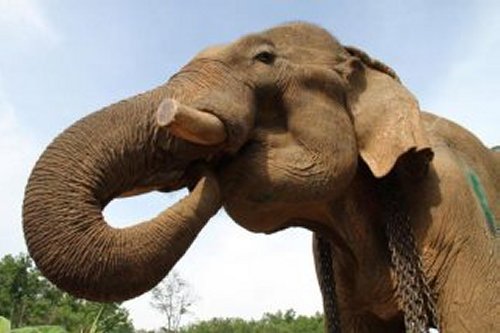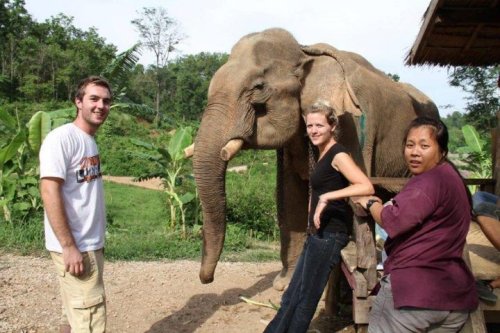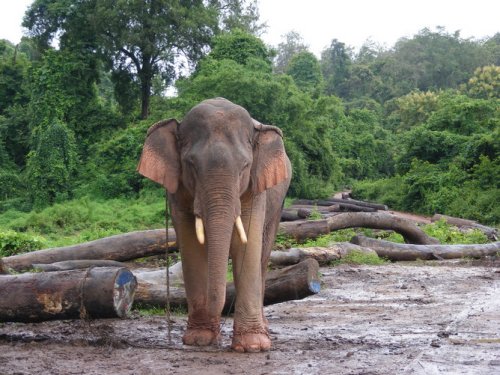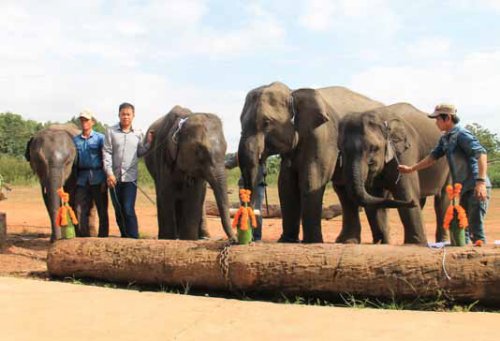Bleak Future For Elephants In Laos
There is no doubt that the elephant populations in Laos, both wild and captive, are in rapid decline. With as few as 470 captive elephants and a lesser number estimated in the wild, the future of this endangered species within Laos is bleak and as such every elephant is significant to its very survival.
As every elephant counts, the ElefantAsia veterinary team has been working around the clock to provide treatment to an elephant suffering from tetanus.
Phu Thongkoon, a bull elephant from Paklai district, was transferred to the Elephant Hospital in Xayaboury province over two weeks ago. Unable to eat, nor drink on his own, the elephant was extremely weak needing injections of anti-toxins to fight the infection. Progress has been slow as the vet team has fed and rehydrated the animal by hand. Little by little there has been marked improvement in Phu Thongkoon’s condition, with the elephant now eating and drinking on his own without any prompting.
Phu Thongkoon’s illness is the first case of tetanus in Laos reported to ElefantAsia in over 10 years of working in the country. Tetanus is extremely rare in elephants and most usually fatal. Specialised literature received from Asian Elephant Range States indicates a greater percentage of fatalities from the disease than of recovery.
Treatment of Phu Thongkoon has cost in excess of US$2,000 and is still rising, however this sick elephant has received tremendous public support from both here in Laos and abroad. Generous donations have been sent to ElefantAsia to ensure Phu Thongkoon receives the best possible care for as long as is needed.
As Phu Thongkoon continues his battle against this life threatening disease, the Asian elephant population in Laos faces its own battle against the threat of extinction. Currently the elephant birth rate in Laos is on average 4-5 births per annum opposed to 15 deaths, a trend which indicates the population is not sustainable. The country has a breeding reservoir of as few as 60 female elephants (those being under the age of 35). An area of particular importance for elephant breeding is Thongmixay, the district remaining the only area in Laos with significant births. The district accounted for 50 percent of elephant births in 2011 and 72 percent d uring 2010.
 The Asian elephant holds great cultural importance in Laos, as well as serving to contribute to the national economy with about 9,000 people across the country reliant on income generated by working elephants. Captive elephants are also a huge draw for international visitors in a growing tourism industry and will provide substantial revenue for Laos in the future.
The Asian elephant holds great cultural importance in Laos, as well as serving to contribute to the national economy with about 9,000 people across the country reliant on income generated by working elephants. Captive elephants are also a huge draw for international visitors in a growing tourism industry and will provide substantial revenue for Laos in the future.
Unquestionably Laos needs to protect its national heritage, and the country needs to safeguard its elephant populations with particular emphasis on its genetic reservoir. This reservoir is imperative to the survival of the species in Laos.
The Non-Governmental Organisation ElefantAsia works in collaboration with the Department of Livestock and Fisheries implementing the Lao Captive Elephant Care and Management Programme which administers free veterinary care to the working elephants of Laos.
The project activities also facilitate the registration and micro-chipping of the captive elephant population which is sponsored by the Critical Ecosystem Partnership Fund. Supporters of the Fund include organisations such as the French Development Agency, World Bank; government of Japan, and the Global Environmental Facility.
Source: elefantasia.org





